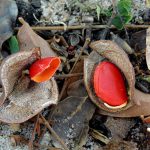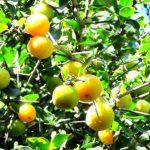TREE LIFE
JULY 1990
MASHONALAND CALENDAR
Monday 2nd July: Mr. R. Pare will be giving an illustrated talk on butterflies in the Riembarta Hatt at 1845 hours for 1900 hours.
Saturday 7th July: Botanic Garden Walk. Park your car at the Herbarium where we will meet Tom Muller at 1045 hours for 1100 hours.
Sunday 15th July: Robin and Kathie McIntosh have invited us to their Bally Vaughan Game Park. No bus this month.
Saturday 28th July: Walk with Mark in the Mukuvisi Woodland. Meet at the main Car park by the office at 1500 hours.
Weekend of 11th, 12th and 13th August: Is anyone interested in a trip to the Chipinge area. We have been invited to visit Silver Streams as guests of Mr and Mrs Rigden. Please phone Maureen Silva Jones on Harare 739711 or Ken Blake on 61348 Bulawayo, before 10th July if you think you would like a change. Once numbers are known plans can be made.
MATABELELAND CALENDAR
On Sunday 1st July we go to the Matopos again, for a morning or all day outing. The Young Ornithologists Club have asked us to teach their members (9 – 12 year olds) Trees and Birds. Meet at Retreat at 0830 hours and go to Effifi Picnic Site. There is a wealth of trees for the morning, then those who have had enough may depart. The rest, after lunch there, go on to the Lower Outspan, at 1430 hours for Tree Bingo and Kids.
Sunday 5th August: To Ponderosa Farm, the home of Colin and Judy Martin, near Esigodini, on the Ncema River. We will also be able to go to High Acres above the upper Ncema Dam area. An all day outing, bring lunch and chairs, and meet at Ascot Car Park at 0830 hours.
On Sunday June 3rd we went to the Matopos, to the Bambata Cave and its approaches. The Paintings, while still clear are fading and future generations will not see them I fear.
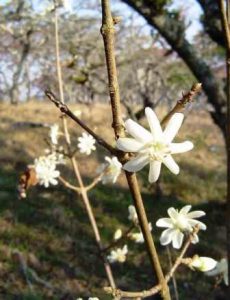
Sericanthe andongensis. Photo: Bart Wursten. Source: Flora of Zimbabwe
We found over 80 tree species. There were no Acacias, but plenty of others : Albizia antunesiana, both light green and purple, Azanza garckeana, Brachylaena rotundata, many, Burkea africana, Cassine matabelica, Catha edulis, widespread, Clerodendrum glabrum, C. myricoides, Combretum apiculatum, C. collinum, C. erythrophyllum, C. hereoense, C. molle, many in fine red leaf, Commiphora marlothii, Croton gratissimus, Dombeya rotundifolia, Elephantorrhiza goetzei, Euclea divinorum, Euclea natalensis, fruiting, E. racemosa, Euphorbia griseola, Faurea saligna, Ficus sur (capensis), F. ingens, F. glumosa (sonderi), many Flacourtia indica, fruiting and in handsome red leaf, Heteropyxis dehniae, widespread, Kirkia acuminata, Lannea discolor, Maytenus heterophylla subsp. puberula, the local subspecies, Maytenus senegalensis, widespread, Nuxia congesta, common on the heights, Ochna schweinfurthiana, Pappea capensis, Pavetta eylesii, some heavily in fruit, Pavetta gardeniifolia (assimilis), Pavetta schumanniana, Protea gaguedi, in flower, Psiadia punctulata, Psydrax livida, (Canthium huillense), Ptaeroxylon obliquum, (sneezewood), Pterocarpus angolensis, a few only, P. rotundifolius, many, Pterolobium stellatum, fruiting heavily, (so that the first Samara, seen on the ground, made me hope for the Violet Tree), Strychnos matopensis, S. madagascariens, Sericanthe andongensis, (neorosea), Tarchonanthus camphorates, Tarenna neurophylla, T. zimbabwensis, Teclea rogersii, Vangueria infausta, Ximenia caffra, Ziziphus mucronata.
-C. Sykes
MATABELELAND NOTES
On Friday 25th May some 34 of us went to Tuli, for a weekend in the Wildlife Society’s Camp on the Shashe River. This was an eye opener, over 500 metres wide, no pools, all filled with sand, but with several shallow waterways coming through the sand, seemingly erratically.
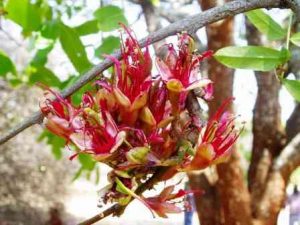
Schotia brachypetala. Photo: Mark Hyde. Source: Flora of Zimbabwe
All along the banks were many huge trees, especially Ficus sycomorus (one of which had a base measure of 9 “Meg units”), Xanthocercis zambesiaca, Nyala tree, Acacia albida, the winter flowering thorn, and a few Schotia brachypetala, one sizeable one in the camp itself. There were really three types of habitat, riverine, a little further away from the banks, and a dryer hinterland.
The west side of the river is the Tuli Circle Hunting Area. It is controlled by National Parks and includes three Botanic Reserves, which were investigated by some members.
There were lion about, one party on the Saturday morning had to beat a hasty retreat, and in the late afternoon again some of us had to retrace our steps from the river bank to find a safer exit. We heard snarling and growling and at night some roaring with plenty of spoor in the sands. I think that the weekend was a great success, largely due to the most welcome support of a strong Harare contingent, without whom we could not have progressed very far, as many of the species were unknown to us. Also many, not actually on the river banks, had very wilted leaves
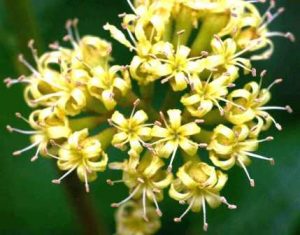
Cordia ovalis. Photo: Bart Wursten. Source: Flora of Zimbabwe
We identified some 55 species – Acacia albida, A. ataxacantha, A. galpinii, A. mellifera, A. nigrescens, A. schweinfurthii, A. senegal var. leiorhachis, A. tortilis, subsp heterocantha, widespread, a few relatively wide apart, on the ground, Adansonia digitata, Albizia brevifolia, A. harveyi, widespread, near to the river, Azanza garckeana, Berchemia discolour, Boscia albitrunca, in the dryer area, Colophospermum mopane, inland in large patches, Combretum apiculatum, leaves on the small side, C. erythrophyllum on the river bank, C. hereroense, C. imberbe, C. mossambicense, Commiphora edulis, G. glandulosa, C. marlothii, C. merkeri, C. tenuipetiolata, Cordia ovalis, which produced a most interesting talk from Kim on the large Hormone content of the BORAGINACEAE and its place in modern Zoology, Croton megalobotrys, widespread on and near the river, Ficus sur, F. sycomorus, Gardenia volkensii, Grewia flava, G. flavescens, G. hornbyi, Hyphaene petersiana, Lonchocarpus capassa, Maerua angolensis, Markhamia zanzibarica, Nuxia oppositifolia, Phyllanthus reticulates, Rhigozum zambesiacum, Schotia brachypetala, Sclerocarya birrea, Sesamothamnus lugardii, Spirostachys africana, Terminalia prunioides, Xanthocercis zambesiaca, Ziziphus mucronata.
-C.Sykes
THE ADVENTURE TRIP TO SHASHI / TULI
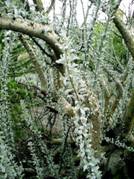
Sesamothamnus lugardii. Photo: J. P. Felu. Source: Flora of Zimbabwe
For many people, including ourselves, the name Shashi is usually associated with a rather sterile trip to Botswana, overgrazed, rundown countryside and a dry river! The more informed members of our group, which consisted of over thirty people, had told us about the lovely trees at Shashi/Tuli, but the sudden burst of magnificent green that greeted us as we approached the camp was nonetheless unexpected and a delightful surprise. There was such a striking contrast between the stunted low veld scrub dotted with Sesamothamnus lugardii, through which we had been travelling a few minutes previously, and the verdant riverine area which we found ourselves. Just gazing up at those splendid trees was a shock to the system.
Neatly and inconspicuously tucked away beneath these magnificent giants the Wildlife Society Camp, Shashi Wilderness, commands a lovely view of the Shashi River, which mostly consists of flood plains of golden sand, several hundred metres in width with the river gently meandering through the midst of them. Being largely subterranean and usually a mere metre across and a few centimetres deep, the river was easily fordable. The worst part of the crossing over to the opposite bank was walking though the soft sand, which became rather tiring on the leg muscles after a while.
Although the camp has two dormitories, many of us opted to camp on the river bank and only made use of the ablution blocks. Six of us actually slept under the stars with the boughs of a beautiful Acacia albida for our canopy. This albida was the usual roosting place of a resident troop of baboons and these rather disgruntled creatures begrudgingly moved to a grove of trees next door. This was rather fortunate for those of us who had chosen to sleep without the protection of a tent, as it could have otherwise been a bit of a messy experience.
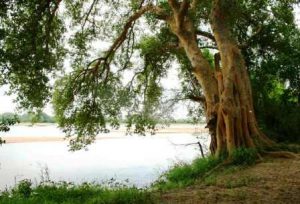
Ficus sycomorus. Photo: Bart Wursten. Source: Flora of Zimbabwe
Directly in front of the camp and graciously lining the river bank were several sturdy, yellow trunked Ficus sycomorus and, just a couple of kilometres downstream, was a grove of these beautiful fig trees, one of which was so large that it took nine people with arms outstretched and fingers touching, to encircle the base of its trunk.
On the bank opposite the camp and within the Tuli Circle was the first of the three Botanical Reserves, the other two, also within the Circle, being further downstream. These reserves, although clearly indicated on our maps, were not actually fenced off or demarcated in any way and we had fun and games in trying to locate them! In point of fact, we did an extensive study of the trees in the area we thought to be the second Botanical Reserve, only to discover that we were in reality, at least a kilometre away from it. The most outstanding features of these reserves were the large specimens of Schotia brachypetala, Xanthocercis zambesiaca, Combretum imberbe and Acacia galpinii. These glorious species often grew to tremendous heights, their branches interlacing to form beautiful panoplies of green, highlighted by the filtered sunlight. We also saw Peltophorum africanum which were outstandingly tall, at least twice the height of what we usually see in Matabeleland.
Other trees worth mentioning in these reserves were Hyphaene petersiana, ilala palm, many of which have unfortunately been abused by the local population to make wine, Croton megalobotrys and lots of Acacia tortilis var. heteracantha.
We also managed to visit Fort Tuli. Apart from the old flagpole, the only thing left of the fort are the half broken down walls of the prison, which apparently had concrete doors and there was no chance of escape once one was securely interned. The Fort itself was built on a hill which has a lovely view of the surrounding countryside. From this view point we could clearly define the dividing line between the aridity of the Circle and the luscious riverine vegetation. Unfortunately we were unable to venture right into the Circle itself, as hunters were in the area.
Tuli Circle is, of course, associated with professional hunting safaris and, as it is right opposite the camp, we saw plenty of evidence of big game and identified elephant, hippo, lion and leopard spoor on the Shashi River floodplains. At night we distinctly hear hyena and jackal calling and a couple of our party heard lion roaring in the distance. We also saw plenty of impala, quite a few kudu, a couple of grysbok, warthog and duiker.
Because we were in the vicinity of a hunting area, we saw a lot of white backed vultures and a couple of lappet faced. But is was interesting to note that there were very few raptors in the area, a pair of tawny eagles, African hawk eagles, bateleur, a fish eagle and even an osprey was seen. This was probable due to the fact that there was very little grass or ground cover in the area and thus not much prey for these fascinating birds to feed on.
All in all, it was a delightful trip and we only wish we had a bit more time to further explore the area. For anyone who has a love and appreciation for all things beautiful, particular trees, we would highly recommend that you take the time to go and see Shashi/Tuli for yourselves. You will not be disappointed.
-Debbi Speller and Peta Ditchburn
AGM MAY 1990 – CHAIRMAN’S REPORT
Another year has slipped by, a year rendered notable by the unusually fine flowering and fruiting of all the bush plants. This has added pleasure to our monthly outings from both the botanical and aesthetic points of view and must, as a bonus, provide a welcome increase in the bird population, especially the seed and fruit eating genera.
Our membership has decreased marginally, overall, but mention must be made of the large increase in membership in Bulawayo. This is due to the enthusiasm and energy of Ken Blake, who seems to come up with bright ideas and better venues all the time.
While on the subject of membership I would like to record the retirement of Brian Best. He has told us that the smell of Eucalyptus is getting stronger every day and thus his long association with the Society is drawing to a close. I hope I may have your agreement in thanking him for all his contributions over the years, and to wish him luck in the land of the Kangaroo Paw.
In addition to arranging what we hope are pleasant and informative local monthly outings your Committee has arranged more ambitious trips lasting several days to the Vumba, Kariba and to Victoria Falls. We hope to arrange a trip to the South East later this year. We have found that it is not possible to arrange National Parks accommodation over various long weekends, as these weekends usually coincide with school holidays when accommodation is allotted by ballot. We cannot, therefore, make a block booking and invite members to apply to fill it.
Members will have noticed the increase in bus fares for outings in which buses are used. This is just part of the unfortunate national financial situation in which we live – we are not making great profits for the Society. At the risk of sounding cynical, I suppose we are lucky that we can still phone up and get a bus for the asking.
Your Committee is pushing ahead with the Tree Mapping exercise, accepting that it is going to be a long, slow business. The areas adjacent to Harare and Bulawayo have been pretty well covered, but check lists from places beyond these centres are always required, and members are requested to send in any information that they can.
As the “green” movement gathers momentum worldwide so the enquiries increase for tree labelling exercises to be carried out. Your Committee is working on the question of labels, which we feel must fulfil several criteria, they must be reasonably priced, they must be visible and easy to read and they must be durable. If any members have any ideas about this matter, then please inform your Committee. The Society is involved, and represented by Kim Damstra, on the body that has been set up to monitor the oil exploration venture in the Zambezi Valley with a view to minimising the impact of this activity on the ecology of the region. We are also involved, again via Kim, in the expansion of the Mukuvisi Woodlands into an Environmental Education Centre.
Tree Life continues to be well received, but contributions are always welcome. Our thanks must go to those who back up its production each month, to Mrs. Johnson who by now knows more Botanical names than does the average Society member (she types the stencils), to Peg Peaceful, who carries out the addressing, to Vida Siebert, who collates and posts and, of course, to all the contributors, especially Dikki Graves, George Hall and Kim Damstra.
I would like to record the Committee’s thanks to Tom Muller for leading our monthly walks through his /garden, and to Mark Hyde for taking parties out whenever he can. On a personal note, I would like to thank all members of the Committee for making my past year in office so pleasant and painless.
AGM AND HARARE BRANCH OUTING AT HARARE SOUTH CLUB: 20TH MAY, 1990
Our AGM was held as above and was quite well attended as my experience of AGMs goes. It is not my function here to give you a report of the proceedings, that is for the Secretary to précis in her minutes. I should however, inform you of the committee to whom the Society has entrusted the running of its affairs. The changes are that yours truly has stood down, to be replaced by Tessa Ball and George Hall. The Committee for the 1990-1991 year then is as follows:
Chairman Dick Hicks
Secretary Maureen Silva Jones
Treasurer Joy Killian
Member Vida Siebert, Tessa Ball, George Hall, Kim Damstra
After the formal proceedings had been completed, the party retired to the further side of the gold course for an enjoyable mornings tree spotting. This is an area of sand veld about 1km south of the Manyame River inhabited by considerable numbers of tobacco farmers and termite mounds.
We parked under some magnificent msasas, Brachystegia spiciformis, where we also later had an agreeable lazy lunch. We soon came upon Senna singueana. This was beginning to produce its egg yolk yellow flowers which earn it the name ‘winter flowering cassia’. Even though most of the leaflets had fallen, one could still see the distinctive ‘bee-sting’ glands along the rachis of the dead leaves.
Grewia monticola and G. flavescens were both present, the former with asymmetric leaves distinctly pale on the underside, the latter with symmetrical leaves with the same shade on both surfaces of the leaves, and having deeply fluted or ‘square’ branches.
The most impressive sight of the day was a spreading Ficus thonningii which, apart from doing a seemingly suicidal self strangulation act was also ‘strangling’ an adjacent Euphorbia ingens, which was a phenomenon new to most of us. Under the branches was a poorly specimen of Canthium lactescens, which grudgingly allowed us to demonstrate the lactating properties of the terminal bud when squeezed.
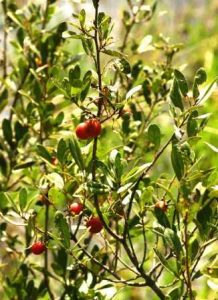
Diospyros lycioides. Photo: Petra Ballings. Source: Flora of Zimbabwe
We were next pleasantly surprised by the sight of Euclea natalensis heavily in fruit, these being small red berries about the size of those on the garden hawthorn. Though quite edible, we did not find them very flavourful. Much the same can be said of the fruit on the next tree we saw which was Diospyros lycioides, the ‘star apple’. Not much like a Star king I am afraid, not being much bigger than a marble in size, and then with the contents largely monopolised by the pip, but the birds are fond of them, so they deserve a place in every garden. Also in fruit but not yet ripe were a fair number of Carissa edulis.
The next high spot of the day was a magnificent Brachystegia glaucescens, rather out of place in this habitat, although I suppose there were some granite rocks about. It had a magnificent spread, and a trunk measuring a full two and a half Meg units. I was a little suspicious of the fairly rough bark and the not so tiny leaflets leading me to suggest that this may have been a hybrid with B. boehmii. Another high spot on the way back was a superb Pterocarpus angolensis, remarkable for its immensely tall, straight trunk, again with a trunk of Meg unit value. Also the distinctive square bark flakes were most prominent.
Getting back to our picnic site, we conveniently encountered both Strychnos spinosa and S. cocculoides close to each other for easy comparison. The latter has a very deeply fissured bark with an almost soft spongy feel to it which the former lacks. S. cocculoides is said to be the one with the pale spots on the fruit. In this locality this was true enough, although the other, S. spinosa also had spots. The difference however is that the spots on S. spinosa are far less distinct and contrast far less with the green back ground. Unfortunately the fruit of neither was ripe.
-J.P.Haxen
NYARUPINDA CATCHMENT
Good wishes for a complete recovery to Bob Drummond, the Herbarium was not the same without him. Tinto has yielded a species of Thesium for him to identify.
Thank you to Derek and Gill Henderson for leading local Tree Society members to an interesting area of riverine vegetation along the Mount Mvurwi Mine road in the Great Dyke. This event took place on Africa Day, more about this in a moment. Derek is qualified to answer all our geological questions, and he explained the unique formation which surrounded us. Were participants aware that the Great Dyke intruded fissures in the granite two thousand five hundred million years ago? This is the age of the rocks we sat on at the picnic. Additional information about rocks and minerals is once again available, inexpensively, at the Government Printer near Meikles Hotel, Harare. The leaflet is the Ministry of Mines Publication No. 1, GEOLOGY. It 16 pages are a very readable refresher course.
Please do not flinch, here is a little more about Medullary Rays. Now that winter has come rays may be observed in the dead or unwanted wood which results from tidying up the garden. Prunings come alive when viewed through a hand lens; one which magnifies ten times the natural size is the best but x 4 is all right. Rubbish from straggling Bauhinia petersiana and B. galpinii, and ancient rose bush or grapevine provide examples of deciduous species. These may be compared with the wood of evergreens such as Eucalypts, conifers, Grevillea robusta, silky oak, and Hakea saligna. If pieces of Azanza garckeana and Uapaca kirkiana are found they show very clearly the components of wood. Inside the home there is no knowing what firewood and pieces of driftwood may reveal about medullary rays.
To conclude this topic here is what Dr. Eduard Strasburger, the 19th Century botanist said about rays of the European Beech tree (Fagus sylvatica) : “living ray cells of over one hundred years old have been found, although, for the most part, they live only about fifty years” in particular it is those cells which store starch. In Africa, Faurea species are known as beech wood, can their cells be so long lived?
Now for something lighter, it is about two birds and a bee. The frost free hill at Tinto abounds with small moths, spiders, wasps and bees which attract the birds. At dusk the Freckled Nightjar comes from the woodland. It began to feed here in March. On the sloping thatch its compact outline is silhouetted against the sky, kluck, kluck cluck and whip wheeu, sounds loud in the stillness as it waits for food. Early in June some Greater Blue eared starlings came to the ancient Acacia nilotica in the garden. A nesting hole in this tree was last used by this species in 1988. In spite of the dogs they are very tame. They sit on the window sills and are unaware that we are very close to them. S. H. Skaife in his book “African Insect Life” describes the Megachilid bee which came to breed in May in crevices under pillows scattered on the verandah furniture. In a few days this grey and white hairy female solitary bee securely fixed three pillows to the chairs. She disregarded us as she brought small discs of thin bark and glistening fragments of tree gum which she cemented together with saliva to form a tube for her eggs. Inevitably the pillow became dislodged and we found the sweet golden paste which she put inside each crust like tube. Rather a sad story, so much effort was wasted.
It is the season of mellow fruitfulness in the bush and in the garden. Many more indigenous trees are in fruit than are in flower. Fruits of Carissa edulis, Diospyros kirkii and Pappea capensis are sought by man and animals. A strong smell coming from the lone Marula tree indicated ripening, a few kilos of marulas were gathered for the sake of their hard won kernels for making biscuits. These juicy fruits have a heavily aromatic acid sweet flavour which is not immediately appealing, an acquired taste. When requested to stew some, the cook made a grimace, laughed and said “aikona”. The vegetable garden situated on rich doleritic clay is burgeoning with produce, everyone ‘pitches in’ to shell the peas, fortunately there are not many pods infested with insects. The depredations made by seed eaters large and small make it difficult to collect useful quantities of tree seeds for the Herbarium. The fruits of leguminous plants are the food of larvae of some moths, beetles and weevils. Select before collect, is advisable and lightens the homeward burden. It is a pleasure to fill the supermarket bag with fruits of Combretum, Terminalias and Monotes, these are some of the easy ones.
New blooms seen recently in the Catchment are Erythrina abyssinica, Faurea speciosa, Dodonea angustifolia, Maytenus heterophylla and M. senegalensis. When Trevor and May Gordon came here recently we walked in the woodland near the house and saw a climbing Asparagus in bloom, Trevor recalled the sight of one that resembled a cascade, it was all spangled with dew.
THE GREAT DYKE
Gill gave each of us a list of trees and shrubs likely to be found; the first one listed was Aloe ortholopha which has been planted at the Mutorashanga crossroad, this species of Aloe occurs only between Mutorashanga and the Mvuradona mountains; Ozoroa longipetiolata, Tapiphyllum velutinum, Ekebergia benguelensis and Maesa lanceolata were seen. Someone remembered that the latex of Stem fruit tree was used as a source of edible gum before the arrival of synthetics. Syzygium cordatum did not look right and was probably an intermediate, since hybridization occurs between S. cordatum and S. quineense. Maybe Ilex mitis towered above us, we did not see it. Several of the species on the list belonged to familiar sand veld woodland. Combretum zeyheri and Diplorhynchus condylocarpon are tolerant of the nickel and chromium in the soils of the dyke. Elephantorrhiza elephantine, Euphorbia wildii and Olinia vanguerioides were not located.
Some of the smaller plants attracted our attention, yellow flowers of Sphedamnocarpus pruriens, purple blooms of Polygala virgata, its specific name means twiggy, both are illustrated on Plate 19 in Margaret Tredgold’s book on wild flowers. Pineapple flower, Eucomis autumnalis grew beside the stream, Plate 4 for this one. The semi-parasite “matches” had a one finger and thumb grip on a Tapiphyllum. The pale velvety leave of the host contrasted with the scarlet flowers of its passenger. Dodonea bore masses of papery fruit which appealed to the fair sex. Ginger bushes emerged from cracks in the rocks.
Underfoot there was an assortment of rocks having plain or banded colours. Something that looked like a chunk of rusted machinery caused quite a stir, Derek identified it as a sesqui-oxide or iron. This was formed when pyroxenite, one of several kinds of rocks in the Dyke, weathered and released iron into the water table. This solution filled lattice like pores and crevices in the layers through which it percolated and a precipitate built up as the water table rose and fell. Eventually the rocks which shaped the deposit disintegrated and left a very hard, heavy, geometrically shaped form of iron ore; this is an on going process. It was fortunate to find this ore in the rubble on the hillside. Fascinating. Leeches at the stream crossing on the rough road resembled algae, so good was their natural camouflage.
Tony and Doreen White from Mhangura, the du Plessis family from Darwendale, Peter Zuaniklen with two guests, Jane McCullam and Mrs Mitchel swelled our numbers for this excursion to the Great Dyke. We enjoyed their company and hope that they enjoyed their day with Ayrshire members of the Tree Society.
Benadicta Graves Raffingora
MUKUVISI WOODLAND NOTES
This month I move away from the game area and into what we call the ‘public walking area’ or PWA. This is not mere verbosity. We have tried other names like ‘wild area’ ‘sango’ but confusion was rampant, i.e. which is the real wild area, inside or outside the fence?
In earlier notes I stuck my neck out and suggested that whereas rapid plant succession is under way inside the game fence, outside we look at a kind of suspended fire induced climax. There is a little succession, the dynamic conditions inside the fence are absent.
Correctly, we are all afraid of fire but in recent years the environment of the PWA has suffered because we have been afraid to manage fire, to dominate it, to make it our servant. If we allow wild fire to rage through the woodland, it does not do so much damage to the vegetation which is all fire tolerant. The damage caused by wild fire is to animal life, the real tragedy in the woodland is when wild fire destroyed nests of hole breeding birds and others. This can be avoided if one grasps the nettle.
I stress management not prevention because in an urban area it is not feasible to prevent fire. There are too many mischief makers. It is always quite significant the incidence of fire goes up the first few days of school holidays. Worst of all are the poachers who burn down wind to drive small buck into the jaws of dogs. I am not advocating smoking but statistically the discarded fag end is low down on the risk list in Mukuvisi. If all else fails, come round about mid September, a fire starts out on the Delport Road, a south-easter drives it down the valley and soon it is in the Woodland, a front of wild fire, a potential killer.
And this brings us to the difference between a hot and a cool burn. Hot burn (wild fire in other vocabularies) makes you run for your life ahead of it. A cool burn allows one to meet it head on and sometimes walk through it.
I was once burning in the north west of the Mukuvisi and, moving towards the oncoming flames I found a steenbok ahead of me. She stood sniffing and looking assessing the fire, and then took three quick jumps, left, two right and she was through the flames. She jumped a bit to make sure no fur was smouldering took off. That is a cool fire. Damage is minimal and disaster can be prevented.
Now this is not to say that hot burning is not an operational tool, but this is a more specialised application in big mammal range management. It is more difficult than a cool burn, its timing it vital and control must be one hundred per cent. Cool and hot burn prescription may be complimentary, it is good management to carry out an early cool burn around an area to be hot burnt later in the year with the objective of enhancing nutrition values.
This month is the start of the fire hazard season in the Mukuvisi.
-G.Hall
OUTING TO CHIPOLI D. SHAMVA : 17TH JUNE 1990
Chipoli D is part of the original estate owned by Captain J. M. Moubray, a mining engineer who decided to settle there in 1911 and who, over the next forty years, worked tirelessly on the development of many dams and weirs with the aim of making use of the water in the Mazowe River which formed part of the estate boundary. It was to the banks of the Mazowe River that we made our way this day.
As is to be expected, we found an unusual selection of interesting trees growing there. Not only is the riverine influence felt, but this area also appears to be a contact zone between the Middle and High veld ecological zones. A good example of this is found when we look at the Combretum sp. that we studied.
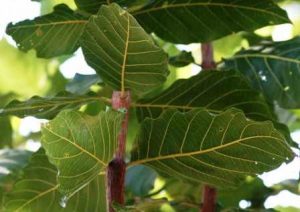
Combretum adenogonium. Photo: Petra Ballings. Source: Flora of Zimbabwe
There was Combretum molle and C. zeyheri, which are common around Harare. We found C. adenogonium, fragrans, and C. apiculatum, both with tertiary veins on their leaves forming a step ladder patter between the secondary veins, but distinguished by the fact that the leaves of the former grow, more often than not, in whorls of three, sometimes four, whereas the latter are usually paired and have more or less twisted, apiculate, tips. These species are also common on the Highveld. The influence of the Middle veld was displayed by C. hereoense and C. elaeagnoides, the latter with quite distinct light brown, smooth, peeling bark, and cordate, wavy edged narrowly elliptic leaves with wall to wall scales visible on the under surface. The riverine and riparian species reflected the same pattern, C. erythrophyllum, a fairly common riverine tree over much of the country, except the Zambezi Valley and Western Matabeleland, and C. mossambicense, which thrives there. The latter is one of several species which are assisted in their scrambling habit by the persistent petioles that form blunt curved pegs to help branches gain and retain a purchase. What makes it different is the very quilted appearance of the leaf blade.
The river banks enabled us to have a look at Ficus capreifolia, riverine sand paper fig, a species that enabled Kim Damstra to deliver veiled but none the less dire warnings of potential agony if the wrong choice is made under certain circumstances. Another species, F. nigropunctata, drew surprised comments for its sheer size, having established itself nicely by a large Kigelia africana and reaching at least four metres.
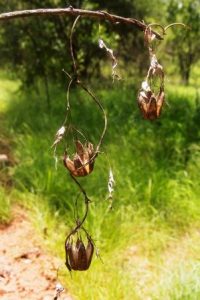
Aristolochia petersiana. Photo: Bart Wursten. Source: Flora of Zimbabwe
The similarity of smell between crushed leaves of ANNONACEAE, custard apple family, and RUTACEAE, citrus family, was noticed by several members. This is because both families have similar oils in their make up. The glands in the leaves of RUTACEAE species can, however, be seen clearly with the naked eye in most cases. Another novel method of separating the families was suggested. First find a Swallowtail butterfly of the sub-genus Papilio or Grophium. The former only lays its eggs on RUTACEAE sp. and the latter on ANNONACEAE. Quite simple really! If you are a right butterfly.
Other lighter moments in a delightful day were provided by the member who fashioned a most attractive pair of earrings out of the pods of Aristolochia petersiana, dutchman’s pipe, a prolific creeper in the area, and by another member who found a very corky barked tree which she christened Albizia cocculoides, it was in fact Albizia harveyi.
There are 87 ticks on the field card for this small segment of Chipoli D, and our thanks go to Sue and Ian Jarvis for enabling us to put them there.
-Dick Hicks
A CANOE TRIP continued
We were shown our rooms and then given a huge breakfast with fried eggs, sausages, boerewors, pancakes and all the trimmings. As it was now after 0900 hours so we really did it justice, as did our men who arrived an hour or so later. Ruckomechi was like paradise after camping on the river, we relaxed, slept after a huge lunch and then some of the party went fishing and the rest of us opted for a game walk escorted by Brian and Lindy. Jim Mackie and Peter a learner guide. It was magical and exciting to be able to observe an elephant so close you could study its eye lashes, our guides were so adept at naming birds and telling us all the imprints and tracks in the sandy river beds. The rains have recently stopped so walking was hazardous, elephant and hippo imprints often inches deep, lots of mud and we returned with wet feet. The camp is set under a grove of enormous Acacia albida. Immediately around the camp is an open plain where we saw several impala. The grass is thick and predators abound. We did not see any but heard them at night and saw many tracks. There is a strip of Croton megalobotrys, the fever berry tree, a favourite of the black rhino, but now growing profusely as there are so few rhino there now. Behind this bush is a wooded area with a great variety of trees including Acacia robusta, A. nigrescens, nyala berry tree, Combretum obovatum, Diospyros, ebony leadwood trees, Combretum imberbe, mopane and Ilala palms. The bird life continued to fascinate us, especially the yellow billed storks paddling in the shallow river as it wound under large trees catching the last of the evening light.
Meanwhile there was much fishing going on with mixed results and I did a bit with a notable lack of success but did get plenty of bites during a memorable afternoon when a total of over 20 tiger were caught. The fishermen had some further success later on and their single mindedness was eventually rewarded on the second afternoon while we were walking when they again got into another large shoal of tiger.
Early the next morning we walked about 10km and again enjoyed Anita’s fabulous catering with another hearty breakfast, a quiet morning in camp, a sleep after lunch and a final walk in the afternoon. Jim and Dave Tredgold joined us and we had a thrill when we were able to watch a Woodland Kingfisher perched over the stream, also a brown hooded Kingfisher, then we found fresh lion spoor and vultures circling near by. We hoped to find the kill and see the lions but were unsuccessful. We then were a bit late for our rendezvous on the river with the fishermen and a sun downer cruise. However, they had waited for us and it was a lovely way to spend our last evening on the mighty Zambezi.
The evenings were taken up with on the first night a slide show of Titch’s slides which were very good for those that could keep their eyes open.
The second night was spent talking and gambling a la Norton. I should have known better than to play “deux mille” with him after my experiences on Blue Convoy years ago but his remarkable skill in games of chance was still there and I broke a world record for the number of “landmines” in one game. “Landmines” can cost a lot of money.
So the grand trip came to a close. The last journey was back up the river to Chirundu and the party was spread among the “banana boat”, the Rukomechi boat and Bens crippled boat and we all got back safely some of us having done in 45 minutes the section of the trip that had taken a full day and a half in our canoes. And so to lunch at the marvellous Norton residence at Chirundu and home after a really splendid five days and all of us wanting to do it all over again.
-Ann and Jim Sinclair
DICK HICKS CHAIRMAN


